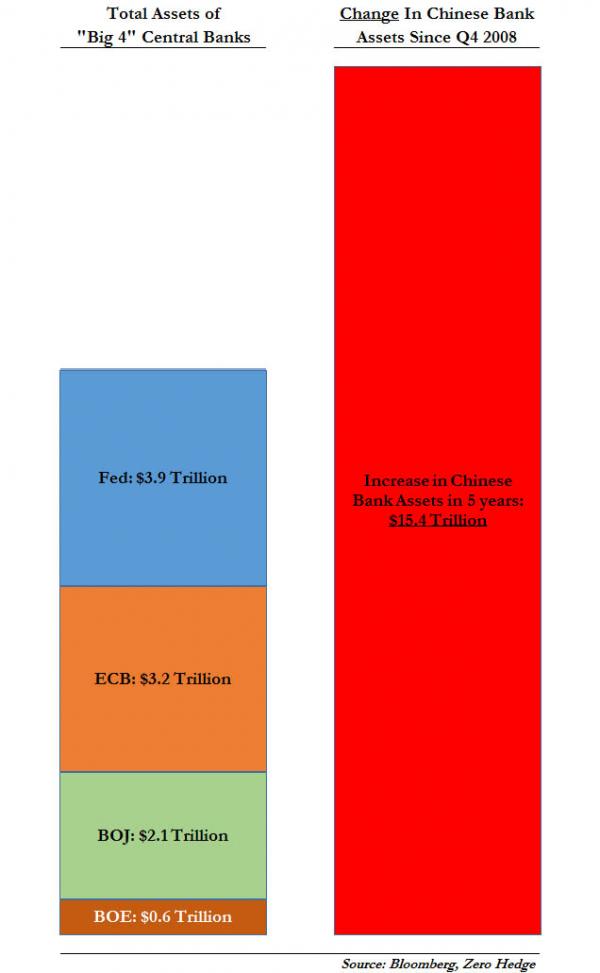|
JOHN RUBINO'SLATEST BOOK |
||||||||||||||||||||||||||||||||||||||||||||||||||||||||||||||||||||||||||||||||||||||||||||||||||||||||||||||||||||||||||||||||||||||||||||||||||||||||||||||||||||||||||||||||||||||||||||||||||||||||||||||||||||||||||||||||||||||||||||||||||||||||
"MELT-UP MONITOR " Meltup Monitor: FLOWS - The Currency Cartel Carry Cycle - 09 Dec 2013 Meltup Monitor: FLOWS - Liquidity, Credit & Debt - 04 Dec 2013 Meltup Monitor: Euro Pressure Going Critical - 28- Nov 2013 Meltup Monitor: A Regression-to-the-Exponential Mean Required - 25 Nov 2013
|
�
"DOW 20,000 " Lance Roberts Charles Hugh Smith John Rubino Bert Dohman & Ty Andros � |
�
HELD OVER
Currency Wars
Euro Experiment
Sultans of Swap
Extend & Pretend
Preserve & Protect
Innovation
Showings Below
��
"Currency Wars "
|
�
"SULTANS OF SWAP" archives open ACT II ACT III ALSO Sultans of Swap: Fearing the Gearing! Sultans of Swap: BP Potentially More Devistating than Lehman! |
�
"EURO EXPERIMENT"
archives open EURO EXPERIMENT :� ECB's LTRO Won't Stop Collateral Contagion!
EURO EXPERIMENT: |
�
"INNOVATION"
archives open |
�
"PRESERVE & PROTE CT"
archives open |
�

�
Fri. Sept 25th, 2015
Follow Our Updates
onTWITTER
https://twitter.com/GordonTLong
AND FOR EVEN MORE TWITTER COVERAGE
�
�
ANNUAL THESIS PAPERS
FREE (With Password)
THESIS 2010-Extended & Pretend
THESIS 2011-Currency Wars
THESIS 2012-Financial Repression
THESIS 2013-Statism
THESIS 2014-Globalization Trap
THESIS 2015-Fiduciary Failure
NEWS DEVELOPMENT UPDATES:
FINANCIAL REPRESSION
FIDUCIARY FAILURE
WHAT WE ARE RESEARCHING
2015 THEMES
SUB-PRIME ECONOMY
PENSION POVERITY
WAR ON CASH
ECHO BOOM
PRODUCTIVITY PARADOX
FLOWS - LIQUIDITY, CREDIT & DEBT
GLOBAL GOVERNANCE
- COMING NWO
WHAT WE ARE WATCHING
(A) Active, (C) Closed
MATA
Q3 '15- Chinese Market Crash
(A)
Q3 '15-
GMTP
Q3 '15- Greek Negotiations
(A)
Q3 '15- Puerto Rico Bond Default
MMC
OUR STRATEGIC INVESTMENT INSIGHTS (SII)

NEGATIVE-US RETAIL
NEGATIVE-ENERGY SECTOR
NEGATIVE-YEN
NEGATIVE-EURYEN
NEGATIVE-MONOLINES
POSITIVE-US DOLLAR
| � | � | � | � | � |
ARCHIVES�
| SEPTEMBER | ||||||
| S | M | T | W | T | F | S |
| � | � | 1 | 2 | 3 | 4 | 5 |
| 6 | 7 | 8 | 9 | 10 | 11 | 12 |
| 13 | 14 | 15 | 16 | 17 | 18 | 19 |
| 20 | 21 | 22 | 23 | 24 | 25 | 26 |
| 27 | 28 | 29 | 30 | � | � | � |
KEY TO TIPPING POINTS |
| 1- Bond Bubble |
| 2 - Risk Reversal |
| 3 - Geo-Political Event |
| 4 - China Hard Landing |
| 5 - Japan Debt Deflation Spiral |
| 6- EU Banking Crisis |
| � |
| 7- Sovereign Debt Crisis |
| 8 - Shrinking Revenue Growth Rate |
| 9 - Chronic Unemployment |
| 10 - US Stock Market Valuations |
| 11 - Global Governance Failure |
| 12 - Chronic Global Fiscal ImBalances |
| 13 - Growing Social Unrest |
| 14 - Residential Real Estate - Phase II |
| 15 - Commercial Real Estate |
| 16 - Credit Contraction II |
| 17- State & Local Government |
| 18 - Slowing Retail & Consumer Sales |
| 19 - US Reserve Currency |
| � |
| 20 - US Dollar Weakness |
| 21 - Financial Crisis Programs Expiration |
| 22 - US Banking Crisis II |
| 23 - China - Japan Regional Conflict |
| 24 - Corruption |
| 25 - Public Sentiment & Confidence |
| 26 - Food Price Pressures |
| 27 - Global Output Gap |
| 28 - Pension - Entitlement Crisis |
| 29 - Central & Eastern Europe |
| � |
| 30 - Terrorist Event |
| 31 - Pandemic / Epidemic | 32 - Rising Inflation Pressures & Interest Pressures |
| 33 - Resource Shortage |
| 34 - Cyber Attack or Complexity Failure |
| 35 - Corporate Bankruptcies |
| 36 - Iran Nuclear Threat |
| 37- Finance & Insurance Balance Sheet Write-Offs |
| 38- Government Backstop Insurance |
| 39 - Oil Price Pressures |
| 40 - Natural Physical Disaster |
�
Reading the right books?
No Time?We have analyzed & included
these in our latest research papers Macro videos!
OUR MACRO ANALYTIC
CO-HOSTS
John Rubino's Just Released Book
Charles Hugh Smith's Latest Books
Our Macro Watch Partner
Richard Duncan Latest Books
MACRO ANALYTIC
GUESTS
F William Engdahl
OTHERS OF NOTE
�
�
TODAY'S TIPPING POINTS
|
�
�
Have your own site? Offer free content to your visitors with TRIGGER$ Public Edition!
Sell TRIGGER$ from your site and grow a monthly recurring income!
Contact [email protected] for more information - (free ad space for participating affiliates).
HOTTEST TIPPING POINTS |
� | � | Theme Groupings |
We post throughout the day as we do our Investment Research for: LONGWave - UnderTheLens - Macro
� |
|||
|
MOST CRITICAL TIPPING POINT ARTICLES TODAY � |
� | � | � |
|
|||
FLOWS - Liquidity, Credit and Debt
|
|||
FLOWS - Liquidity, Credit and Debt Submitted by�Tyler Durden�on 09/23/2015 14:39 "Why Has It Suddenly Stopped Working": The Chart Every Trader Is Losing Sleep OverIn a must-read report which we will deconstruct shortly, Citi's Matt King (who, as a reminder, is the person whose "Are the Brokers Broken" report issued in the first week of September 2008 was, according to many, one of the catalysts for Lehman's failure simply by explaining to a largely clueless Wall Street just how broken the US financial system had become in late 2008) hits it out of the park with just one chart from his latest presentation, the chart which every market bull - whether they know it or not - is losing sleep over:��has the only thing that has worked in the past 7 years, namely the central bank QE transmission channel, broken down. Or, as Citi's Matt King notes in what may be the only chart which traders should be obsessing over, "why has it suddenly stopped working", by which he means the market's favorable reaction to central bank liquidity injections. His question: "have central banks lost their touch" and points out that while in the past QE injections have always resulted in improving risk asset prices (in this case represented by junk bond returns),�this time is different. The answer will determine whether the next move in the market is 20% higher or lower. � |
|||
Submitted by�Tyler Durden�on 09/23/2015 18:27�
Your Complete Guide To A World In Which The Fed Is No Longer In ControlBack in�December 2013�we pointed out something that virtually nobody had noted or discussed: when it comes to "credit" creation, China's $15 trillion in freshly-created bank loans since the financial crisis - ostensibly the global credit buffer that allowed China to not get dragged down by the western recession - dwarfed the credit contribution by DM central banks. This is how we simplified what was happening at the time:
This dramatic divergence in credit creation continued for about a year, then gradually Chinese new loans topped out primarily due to regulation slamming shut�debt creation in the shadow banking space,�and since credit accumulation resulted in parallel build up in central bank reserves, the current period of debt creation going into reverse has led to not only China's currency devaluation but what we first warned was�Reverse QE, and has since picked up the more conventional moniker "Quantitative Tightening." But while China's credit topping process was inevitable, a far more sinister development has emerged: as weshowed earlier, while DM central banks - excluding the Fed for the time being - have continued to pump liquidity at full blast into the global, fungibly-connected, financial system, there has been virtually no impact on risk assets... ... especially in the US where the S&P is now down not only relative to the end of QE3, but is down 5% Y/Y - the biggest annual drop since 2008. This cross-flow dynamic is precisely what David Tepper was�trying to explain to CNBC two weeks ago�when the famous hedge fund manager declared the "Tepper Top" and went quite bearish on the stock market. This dynamic is also the topic of a must-read report by Citi's Matt King titled quite simply: "Has the world reached its credit limit?" and which seeks to answer a just as important question: "Why EM weakness is having such a large impact", a question which we hinted at 2 years ago, and which is now the dominant topic within the financial community, one which may explain why development market central bank liquidity "has suddenly stopped working." King's explanation starts by showing, in practical terms, where the world currently stands in terms of the only two metrics that matter in a Keynesian universe: real growth, and credit creation. His summary:�there has been plenty of credit,�just not much growth. So the next logical question is where has this credit been created. Our readers will know the answer: the marginal credit creator ever since the financial crisis�were not the DM central banks�- they were merely trying to offset private sector deleveraging and defaults; all the credit growth came from Emerging Markets in general, and China in particular. So while we now know that EMs were the source of credit creation, why care? Why does it matter if credit was mostly being created in EMs vs DMs, and isn't credit created anywhere essentially the same? The answer is a resounding no,�as King further explains. First, looking at credit creation in the post-crisis developed markets reveals something troubling: because credit creation takes places mostly in markets and is locked in central bank "outside" money which does not enter the broad monetary system, as opposed to bank credit creation in which banks issue loans thereby creating both new loans and deposits, i.e., money, the direct impect of DM central bank liquidity injections has been to created asset-price inflation. However, the offset has been far lower broad money creation - as there is far less credit demand in the first place - leading to no incremental investment, and far lower economic multipliers. Alternatively, it should come as no surprise that credit creation in EMs is the opposite: here money creation took place in the conventional loan-deposit bank-intermediated pathway, with a side effect being the accumulation of foreign reserves boosting the monetary base. Most importantly, new money created in EMs, i.e., China led to new investment, even if that investment ultimately was massively mis-allocted toward ghost cities and unprecedented commodity accumulation. It also led to what many realize is the world's most dangerous credit bubble as it is held almost entirely on corporate balance sheets where non-performing loans are growing at an exponential pace. The good news is that at least initially the EM credit multiplier is far higher than in the DM. The bad news, is that even the stimulative effect of the EM multiplier is now fading. As a result, instead of going toward economic growth, even EM credit creation has been corrupted by the "western" bug, and is being allocated toward asset-price inflation... such as housing and markets. * * * The above lays out the market dynamic that took place largely uninterrupted from 2008 until the end of 2014. And then something changed dramatically. That something is what we said started taking place last November when we pointed out the "death of the petrodollar", when as a result of the collapse in oil prices oil exporters started doing something they have never done before: they dipped into their FX reserves and started selling. This reserve liquidation first among the oil exporting emerging market, is essentially what has since morphed into a full blown capital flight from the entire EM space, and has also resulted in China's own devaluation-driven reserve (i.e., Treasury) liquidation, which this website also noted first back in May. As King simply summarizes this most important kink in the story, after years of reserve accumulation, EMs have now shifted to reserve contraction which, in the simplest possible terms means, "money is being destroyed"which in turn is the source of the huge inflationary wave slowly but surely sweeping over the entire - both EM and DM - world. Ok, EMs are selling. But where is the money going? And won't dumping of Treasurys push yields higher. Answering the second question first, we remind readers of a note from several weeks ago titled "Why China Liquidations May Not Spike US Treasury Yields" which is precisely what DB also said, and which Citi agrees with: while there may be upward pressure on yields it will likely be temporary, especially if there is an even greater risk-aversion reaction in risk assets. The result to EM TSY selling would be a selloff in stocks, which in turn would push investors into the "safety" of bonds, thus offsetting Chinese selling. But while one can debate what the impact on money destruction would be on equities and treasurys, a far clearer picture emerges when evaluting the impact on the underlying economy. As King, correctly, summarizes without the capex boost from energy (which won't come as long as oil continues its downward trajectory), and DM investment continues to decline, there is an unprecedented build up in inventory, which in turn is pressuring both capacity utilization, the employment rate, and soon, GDP once the inevitable inventory liquidation takes place. The take home is highlighted in the chart above, but just in case it is missed on anyone here it is again: the"fundamentals point overwhelmingly downwards." But wait, won't central banks react this time as they have on all those prior occasions (QE1, QE2, Operation Twist, QE3, BOE QE1, BOJ QQE1, ECB QE1, etc)? Well, they'll surely try... but even they know that every incremantal attempt to stimulate the private sector will have increasingly less impact. In other words, the CBs are not out of firepower, it is just that their ammo is almost nil. The reason for that: the "multiplier have fallen" because after 7 years of doing the same thing, this time it just may not work... Furthermore, while we have listed the numerous direct interventions by central banks over the past 7 years, the reality is that an even more powerful central bank weapon has been central bank "signalling", i.e., speaking, threatening and cajoling. As Citi summarizes�"The power of CBs’ actions has stemmed more from the signalling than from the portfolio balance effect." So now that the "signalling" pathway is fading, all that's left are the flows - the same flows which, with very good reason,�left David Tepper scratching his head. Flows, which, when one takes into account emerging market reserve liquidation to offset central bank purchases, paints� a very ugly picture: one in which the central banks are for the first time since 2009, finally losing control as their�inflows are unable to offset the EM�outflows. Where does that leave us? Well, all else equal, the�New New Normal, the world in which central banks are no longer in control as a result of EM reserve liquidation, will be world in which slower credit growth translated into, you guessed it, slower overall growth, or as Citi states the conudnrum: "Even a deceleration in credit growth is negative for GDP growth." This is precisely the secular stagnation which we have been warning about since 2009. * * * What is the conclusion? It's not a pretty one for either the central bankers, nor the Keynesian economists, nor those who believe asset prices can keep rising in perpetuity, because it means that payment for the free lunch from the past 7 years is finally coming due. But at least it is a simple conclusion: we are now at the credit plateau, or as Citi puts it:�"Credit growth requires willing borrowers as well as lenders;�we may be nearing the limits for both." � |
|||
| MOST CRITICAL TIPPING POINT ARTICLES THIS WEEK -Sept 20th, 2015 - Sept. 26th, 2015 | � | � | � |
| BOND BUBBLE | � | � | 1 |
| RISK REVERSAL - WOULD BE MARKED BY: Slowing Momentum, Weakening Earnings, Falling Estimates | � | � | 2 |
| GEO-POLITICAL EVENT | � | � | 3 |
| CHINA BUBBLE | � | � | 4 |
| JAPAN - DEBT DEFLATION | � | � | 5 |
EU BANKING CRISIS |
� | � | 6 |
| � | |||
GLOBAL GROWTH |
� | � | 8 - Shrinking Revenue Growth Rate |
Submitted by�Tyler Durden�on 09/22/2015 22:13 ADB Joins OECD, WTO In Dismal Assessment Of Global GrowthExactly a week ago,�we highlighted�a WSJ piece which quoted WTO chief economist Robert Koopman as saying the following about the outlook for global growth: “We have seen this burst of globalization, and now we’re at a point of consolidation, maybe retrenchment.�It’s almost like the timing belt on the global growth engine is a bit off or the cylinders are not firing as they should.”� Explaining further, The Journal�noted�that “for the third year in a row, the rate of growth in global trade is set to trail the already sluggish expansion of the world economy.”� In no uncertain terms: global growth and trade are grinding to a halt, something we’ve been keen to drive home this year using a variety of data points not the least of which are freight rates which, as Goldman noted back in May are likely to remain depressed until 2020, dead cat bounces in the Baltic Dry notwithstanding (for more on this, see�here).� All of the above was confirmed last Wednesday by the OECD�which cut�their forecast for global growth to 3% in 2015 and 3.6% in 2016.� Of course one of the main problems is decreased demand from China, where sharply decelerating economic growth threatens to plunge the entire emerging world into crisis as the country’s previously insatiable appetite for raw materials suddenly disappeared leaving countries like Brazil out in the cold. Also hard hit is emerging Asia, where the turmoil in China combined with the threat of an imminent Fed hike has created conditions that may ultimately usher in the return of the 1997/98 Asian Currency Crisis (indeed, Malaysia’s central bank governor Zeti Akhtar Aziz has been at pains to reassure the market that the country isn’t set to return to capital controls to shore up the plunging ringgit).� Against this backdrop it shouldn’t come as a surprise that the�ADB slashed its growth outlook for the region on Tuesday citing a laundry list of factors,�most of which are outlined above. Here’s�more:
As that pretty much speaks for itself, we'll close with what we said last week in the wake of the OECD's most recent report:��
|
|||
| TO TOP | |||
| MACRO News Items of Importance - This Week | |||
GLOBAL MACRO REPORTS & ANALYSIS |
� | � | � |
US ECONOMIC REPORTS & ANALYSIS |
� | � | � |
| CENTRAL BANKING MONETARY POLICIES, ACTIONS & ACTIVITIES | � | � | � |
| � | � | � | |
| Market | |||
| TECHNICALS & MARKET | � |
� | � |
| COMMODITY CORNER - AGRI-COMPLEX | � | PORTFOLIO | � |
| SECURITY-SURVEILANCE COMPLEX | � | PORTFOLIO | � |
| � | � | � | |
| THESIS - Mondays Posts on Financial Repression & Posts on Thursday as Key Updates Occur | |||
| 2015 - FIDUCIARY FAILURE | 2015 | THESIS 2015 |  |
| 2014 - GLOBALIZATION TRAP | 2014 |  |
|
|
2013 2014 |
|||
2011 2012 2013 2014 |
|||
| � | � | ||
| THEMES - Normally a Thursday Themes Post & a Friday Flows Post | |||
I - POLITICAL |
� | � | � |
| CENTRAL PLANNING - SHIFTING ECONOMIC POWER - STATISM | � | THEME | � |
- - CORRUPTION & MALFEASANCE - MORAL DECAY - DESPERATION, SHORTAGES. |
� | THEME |  |
| - - SECURITY-SURVEILLANCE COMPLEX - STATISM | M | THEME | � |
| - - CATALYSTS - FEAR (POLITICALLY) & GREED (FINANCIALLY) | G | THEME | � |
II-ECONOMIC |
� | � | � |
| GLOBAL RISK | � | � | � |
| - GLOBAL FINANCIAL IMBALANCE - FRAGILITY, COMPLEXITY & INSTABILITY | G | THEME | � |
| - - SOCIAL UNREST - INEQUALITY & A BROKEN SOCIAL CONTRACT | US | THEME | � |
| - - ECHO BOOM - PERIPHERAL PROBLEM | M | THEME | � |
| - -GLOBAL GROWTH & JOBS CRISIS | � | � | � |
| - - - PRODUCTIVITY PARADOX - NATURE OF WORK | � | THEME | MACRO w/ CHS |
| - - - STANDARD OF LIVING - EMPLOYMENT CRISIS, SUB-PRIME ECONOMY | US | THEME | MACRO w/ CHS |
III-FINANCIAL |
� | � | � |
| FLOWS -FRIDAY FLOWS | MATA RISK ON-OFF |
THEME | |
| CRACKUP BOOM - ASSET BUBBLE | � | THEME | � |
| SHADOW BANKING - LIQUIDITY / CREDIT ENGINE | M | THEME | � |
| GENERAL INTEREST | � |
� | � |
| STRATEGIC INVESTMENT INSIGHTS - Weekend Coverage | |||
� � � |
� | SII | |
� � � |
� | SII | |
� � � |
� | SII | |
� � � |
� | SII | |
| TO TOP | |||
| � | |||
�
Read More - OUR RESEARCH - Articles Below
Tipping Points Life Cycle - Explained
Click on image to enlarge
 ���
���
TO TOP
�
�
�
�
�� TO TOP
�
�
























































